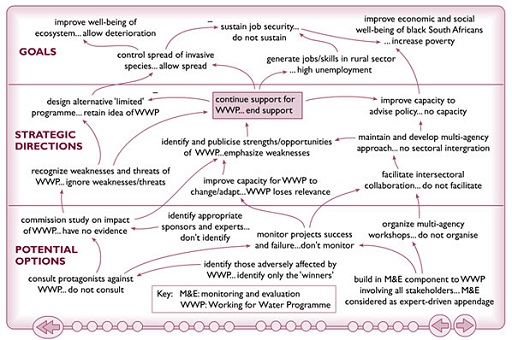3.6 Final diagram
You may wish to refer back to the WWP case study as you work through the activity on this page.
For a printable A4 size copy of this diagram, click on ‘View document’.
View document [Tip: hold Ctrl and click a link to open it in a new tab. (Hide tip)]
Activity 8 Construct a cognitive map
Either:
- Choose an issue associated with the South African Working for Water Programme around which a decision is required. This can be the same as used in the animated tutorial (decision on whether to continue support for WWP) or you can explore a different issue that might have arisen from other diagramming activities, for example, a 'decision on implementing inter-sectoral collaboration'.
- Choose an issue where a particularly important decision was made or required in order to carry out an intervention. The issue you choose can either relate to your own experience or to what you have already studied in this unit.
Construct a cognitive map following the guidelines below.
- Devise a bipolar construct around the key decision.
- Distinguish between three levels of planning (from bottom to top): goals (ideals); strategic options (objectives); and potential options (tasks).
- Trace the immediate and less immediate implications (goal-orientation) in terms of consequences of the decision, constructing bipolar constructs for each perceived consequence (i.e. forecasting).
- Ask yourself what (task-oriented) actions are required in order to bring about the decision being made. (i.e. backcasting) and represent these actions as bipolar constructs on your cognitive map.
- Ensure that your links between bipolar constructs are logically constituted (first pole of tail construct leads to first pole of head construct). If not put in a minus sign on the arrow.
Examine your cognitive map and note down the key and possibly contentious assumptions relating to different parts of the decision making process, and implications with regards to immediate actions required to progress the interventions.

